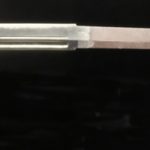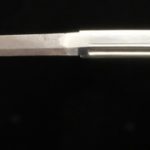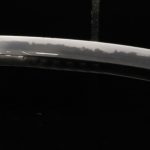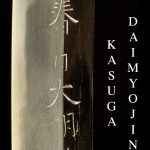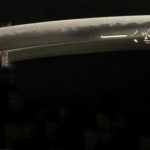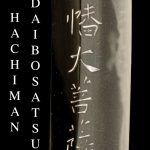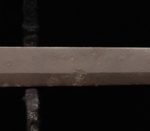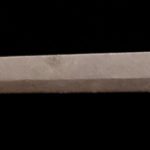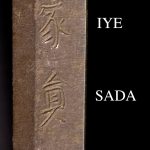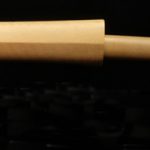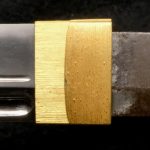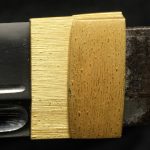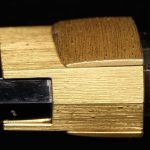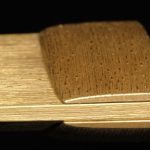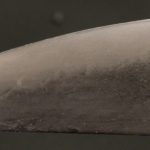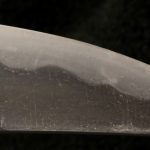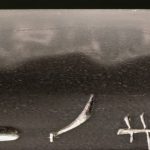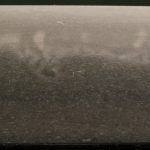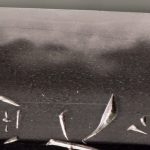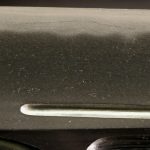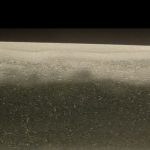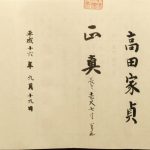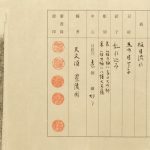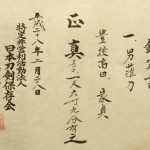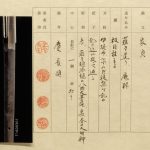IESADA / NAGINATA / NTHK
IESADA, BUNGO TAKADA
NAGINATA
NTHK X 2
SUGATA: NAGINATA
MEI: IESADA (BUNGO TAKADA)
DATE: NONE c. TENMON 1532 (NTHK) / KEICHO c. 1596 (NTHK-NPO)
NAGASA: 31.5cm (20.25″)
OVERALL: 103.7cm (40.75″)
MIHABA: 3.016cm (1.1875″)
KASANE: 0.794cm (0.3125″)
SORI: 1.4375
NAKAGO: UBU
MEKUGI ANA: ONE
YASURIME: YOKOYASURI OR KIRI
MUNE: IORI
HADA: ITAME
HAMON: GUNOME MIDARE with ASHI, YO, ETC.
BOSHI: CHOJI MIDARE KOMI
HORIMONO OMOTE: NAGINATA HI with MYOGO
HORIMONO URA: NAGINATA HI with MYOGO
HABAKI: 2 PC. GOLD FOIL by BRIAN TSCHERNEGA
SHIRASAYA
Outstanding signed, papered, ubu naginata by Takada Iesada, it is signed niji mei (two character). It is so nice to find naginata which have not been cut down. This flawless naginata is in excellent condition and polish. The hada is Itame with chikei. The hamon is an extremely active gunome midare with tons of hataraki guaranteed to provide endless study pleasures. There are clouds of nio with nie, ashi, yo, inazuma, yubashiri etc., etc.
There is naginata hi and on both sides there are Myogo inscribed.
One side reads:
Hachiman Daibosatsu (Great Buddha to be), known as the God of War or the Tutelary God Warriors is inscribed on the left side.
During the age of the samurai, descendants of both samurai clans, Seiwa Genji (清和源氏 Seiwa Gen-ji, a line of the Minamoto clan descended from Emperor Seiwa) and Kanmu Taira (桓武平氏 Kanmu Taira’u-ji/ Hei-shi/ Hei-ji, a line of the Taira clan descended from Emperor Kanmu) honored Hachiman, from which the tradition is derived nationwide in which samurai clans (武家 “buke” in Japanese) honor Hachiman as the deity sacred to them. His other roles include determining a samurai’s fate—i.e., whether they are a success or failure in battle; controlling and protecting the martial arts; and proclaiming the victory of an army.1
The other side reads:
Kasuga Daimyojin which is reference to both the Kasuga-taisha or shrine as well as the collective deities (Kami) associated with the shrine is inscribed on the right side.
The birth of the Kasuga-taisha shrine, according to legend, began when the first kami of Kasuga-taisha, Takemikazuchi, rode on the back of a white deer to the top of Mount Mikasa in 768 BC. This kami is said to have traveled from the Kashima Jingu Shrine in order to protect Nara. The shrine location first received favor from the Imperial government in the Heian period as a result of the power from the Fujiwara family as well as Empress Shōtoku.1
The four main kami enshrined here are Ame no koyane, Himegami, Futsunushi no mikoto, and Takemikazuchi no mikoto. Though these are the primary divine beings of Kasuga taisha, they are often grouped together as a syncretic, combined deity known as Kasuga Daimyōjin. Kasuga Daimyōjin is composed of five divine beings and each consists of a Buddhist deity and Shinto kami counterpart. The fifth deity, Ame-no-Oshikumone, was added much later and is said to be the divine child of Ame no koyane and Himegami. The importance of the multifaceted kami was that it became a template for future worshipers who wanted to combine several deities to pray to at once.1
Forged in a period steeped in war prior to the unification of Japan by Oda Nobunaga, Toyotomi Hideyoshi, and Tokagawa Ieyasu. While a beautiful work of art, make no mistake this blade was made for battle and carried prayers of victory and protection for whoever wielded it.
This naginata comes with not one, but two sets of papers. Both NTHK & NTHK-NPO authenticated this mei as shoshin. The NTHK-NPO gave this naginata an outstanding 77 pts., which is equivalent to the NBTHK Tokubetsu Hozon.
An added benefit is the two piece gold habaki made the master maker Brian Tschernega.
This sword comes with a 48-hr. inspection period.
Please refer to the Policy Page for complete details.
$5500 plus S/H
